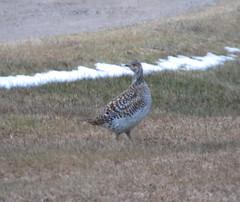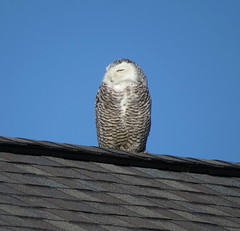Spring Valley Wildlife Area & Caesar Creek S.P.
Do you realize how difficult it was this weekend not to go chasing rarities? First we have a Western Grebe across the Ohio River from Louisville. Then we have a Spotted Redshank, code 4 mind you, at Goose Pond, also in Indiana. Then to top it off a Cinnamon Teal in Lexington. As much fun it is to chase rare and unusual birds, especially if they’re close to home, I’m not particularly upset. Sure it would have been nice to tick off another life bird, but it is Easter weekend and my daughter and husband came home and any time spent with them trumps any bird. This doesn’t mean I didn’t go birding.
Saturday bright and early I meet up with Jon at the McDonalds in Waynesville for a little trip to Spring Valley and Caesar Creek. This is one of the nice things about living where I do. These two places are within an easy drive and I can get home in time to visit more with my daughter.
The sun was just rising and shedding a little light on what would be a beautiful day, as we made our way down from the parking lot to Spring Valley’s boardwalk. I was hoping for some early Sora activity and I brought my Ipod to entice them into calling. No luck.
 Spring Valley has so much to offer the birder. Trails that wind around through the woods, open farmland all around the wildlife area, a nice lake with a marsh that has a trail that circumvents the lake. Now wonder that the Ohio Ornithological Society is hosting a field trip here on the 14th of April.
Spring Valley has so much to offer the birder. Trails that wind around through the woods, open farmland all around the wildlife area, a nice lake with a marsh that has a trail that circumvents the lake. Now wonder that the Ohio Ornithological Society is hosting a field trip here on the 14th of April.
Back in December Jon and myself were here we were able to hear and get good views of Marsh Wrens. During the Winter these are kind of rare. And yesterday we heard and saw them again, this time we feel there were more than just a couple. So when I submitted the day list to eBird I had to justify my sighting, but they were there and still a nice bird.
We spent a couple of hours here and afterward we headed over to Mounds Road which dead ends at the mudflats at Caesar Creek. Even though it’s early Spring we were hoping that some wading birds might start to show up like Greater and Lesser Yellowlegs.
 But as luck would have it, especially this year, it was a bust. Not even a Killdeer I’m not sure what it is about Caesar Creek this year, but I usually have some decent birding here during the colder months and early Spring. Just not this year so far.
But as luck would have it, especially this year, it was a bust. Not even a Killdeer I’m not sure what it is about Caesar Creek this year, but I usually have some decent birding here during the colder months and early Spring. Just not this year so far.
It wouldn’t be a trip here without a visit to Harverysburg Road and see if anything was on the water. The lake was as quiet as I’ve sen in months, which can account for the quietness of the birds on the water.
 However there was this Common Loon and as you can see it’s in breeding plumage. He was feeding off the end of Harveysburg Road and if you’ve ever tried to get a picture of a Loon while it’s feeding, it can prove to be a difficult task. It seems that they’re on the surface of the water for no more than 10 seconds till they dive again. And when they do come up they could be anywhere. So as a digiscoper I have to get my scope back on the bird, attach the camera and try to focus and get the picture off before it dives again. I have a great picture just as it submerges but I thought you’d rather not see that one.
However there was this Common Loon and as you can see it’s in breeding plumage. He was feeding off the end of Harveysburg Road and if you’ve ever tried to get a picture of a Loon while it’s feeding, it can prove to be a difficult task. It seems that they’re on the surface of the water for no more than 10 seconds till they dive again. And when they do come up they could be anywhere. So as a digiscoper I have to get my scope back on the bird, attach the camera and try to focus and get the picture off before it dives again. I have a great picture just as it submerges but I thought you’d rather not see that one.
Our last stop was the nature center. They have a mature section of evergreen trees and the hopes were some Pine Warblers. We were able to pick up a couple through their call, but no visual on them. This is one of my favorite spots at the park and as we walked on the trail some of the early Spring Flowers were in bloom. I left my camera in the car so nor pictures. They were small and blue and star shaped. Other than that I’ll let my fellow blogger at “Seasons Flow” tell me what it might be.
I could have stayed out all day, it was so nice. Missing out on some rarities just goes with being a bird watcher. There’s always another bird to see.
Notable birds for the day include:
- Hooded Merganser
- Red-breasted Merganser
- Horned Grebe
- Pied-billed Grebe
- Canada Geese
- Bufflehead
- Red Head
- Gadwall
- Mallard
- Lesser Scaup
- Blue-winged Teal
- Wood Duck
- Northern Shoveler
- Ring-necked Duck
- American Coot
- Common Loon
- Black Vulture
- Turkey Vulture
- Red-tailed hawk
- Red-shouldered Hawk
- Red-bellied Woodpecker
- Downy Woodpecker
- Hairy Woodpecker
- Northern Flicker
- Yellow-bellied Sapsucker
- Tree Swallow
- Pine Warbler
- Yellow-rumped Warbler
- Song Sparrow
- American Tree Sparrow
- Swamp Sparrow
- White-throated Sparrow
- Carolina Wren
- Marsh Wren
- Mourning Dove
- Red-winged Black Bird
- Brown-headed Cowbird
- Common Grackle
- American Goldfinch
- Eastern Bluebird
- Eastern Meadowlark
- Eastern Towhee
- Common Crow
- Dark-eyed Junco
- Northern Cardinal
- Tufted Titmouse
- Carolina Chickadee
- Blue Jay
- White-breasted Nuthatch
- Red-breasted Nuthatch
- Belted Kingfisher
- Northern Mockingbird
















